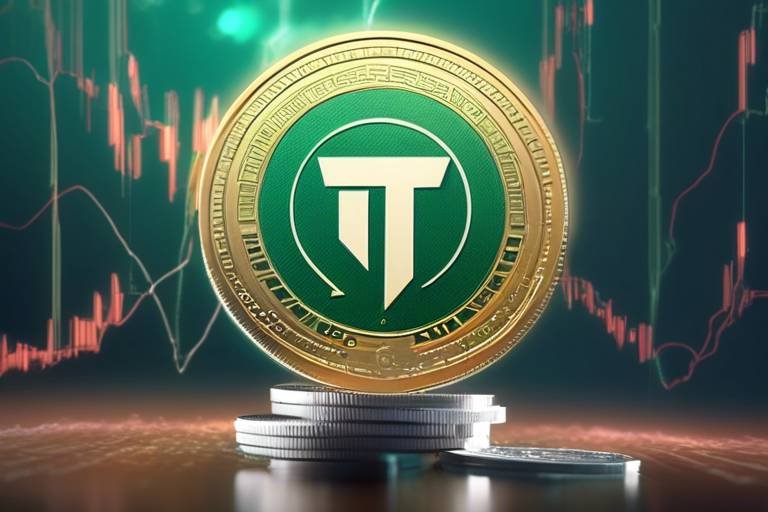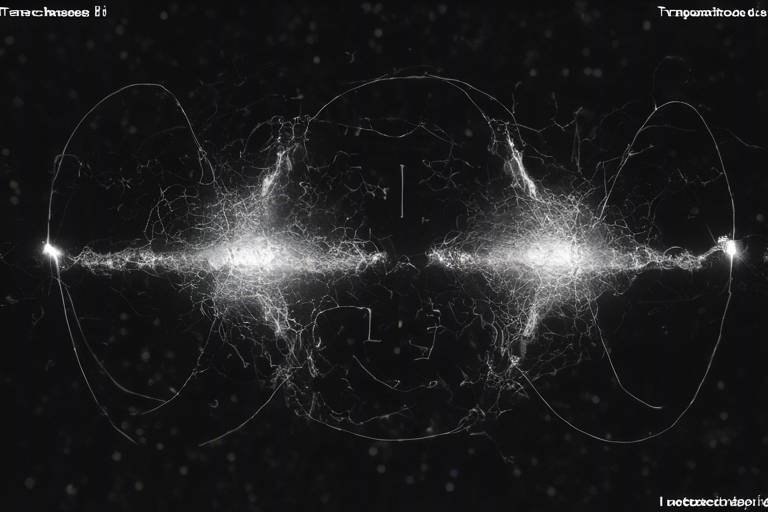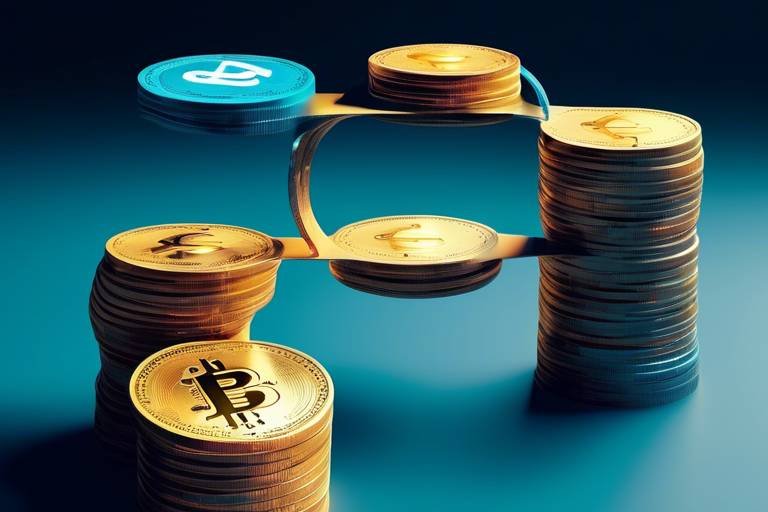Terra (LUNA) - An In-Depth Review of Its Ecosystem
Welcome to the fascinating world of Terra, where blockchain technology meets innovation! In this article, we will delve into the Terra ecosystem, exploring its unique features, the pivotal role of its native token LUNA, and how it’s shaping the blockchain landscape. If you're curious about how Terra is not just another cryptocurrency but a complete ecosystem with potential and challenges, you’re in the right place!
The architecture of Terra is a masterclass in design, aimed at facilitating scalable and efficient transactions. At the core of its architecture is a proof-of-stake consensus mechanism, which not only enhances security but also decentralizes the network. This means that instead of relying on a few powerful entities, the power is distributed among various stakeholders, making the network more resilient. Imagine a community where everyone has a voice, contributing to a collective decision-making process—that’s the essence of Terra’s architecture!
LUNA is more than just a token; it’s the lifeblood of the Terra ecosystem. Serving as the native cryptocurrency, LUNA plays a crucial role in governance, staking, and maintaining the stability of Terra's stablecoins. Think of LUNA as the oil in a well-oiled machine, ensuring everything runs smoothly. Its influence extends to various functionalities of the platform, impacting everything from transaction fees to voting rights in governance decisions.
Staking on Terra is an exhilarating way for users to earn rewards while contributing to the network's security. By locking up their LUNA tokens, participants help validate transactions and keep the network running efficiently. The benefits for stakers are substantial; they not only earn rewards but also play a vital role in maintaining the ecosystem's integrity. It's like being part of a club where your contributions are recognized and rewarded!
The selection of validators is a crucial aspect of the Terra network's performance. Validators are chosen based on their stake and reputation, and they are responsible for validating transactions and securing the network. This process ensures that only reliable and trustworthy participants are given the chance to contribute to the network. The performance of these validators directly impacts the overall health of the Terra ecosystem, making their selection process vital.
Understanding how rewards are distributed among stakers is essential for anyone considering participating in staking. The reward structure is influenced by several factors, including the amount of LUNA staked and the overall network performance. Participants can expect to receive a share of the transaction fees and block rewards, making it a lucrative opportunity for those who are willing to lock up their tokens for a while. It’s like planting a seed and watching it grow into a fruitful tree!
Stablecoins are the cornerstone of the Terra ecosystem, providing much-needed price stability for users. Unlike traditional cryptocurrencies that can be volatile, Terra's stablecoins are pegged to real-world assets, ensuring that their value remains consistent. This stability is crucial for facilitating transactions and building trust among users. The mechanisms behind Terra's stablecoins are intricate yet fascinating, allowing for seamless transactions while minimizing the risks associated with price fluctuations.
Terra's ecosystem supports a wide array of applications, ranging from decentralized finance (DeFi) projects to e-commerce platforms. Each use case contributes to the platform's growth and adoption, showcasing the versatility of the Terra ecosystem. Whether you're a developer looking to build the next big DeFi application or a consumer wanting to make online purchases with ease, Terra has something for everyone!
The DeFi landscape on Terra is rapidly evolving, with numerous applications making waves in the industry. These DeFi projects leverage Terra's unique features, such as low transaction fees and fast processing times, to enhance user experience. From lending platforms to decentralized exchanges, the possibilities are endless. It’s like having a toolbox filled with innovative solutions, all designed to empower users and revolutionize the way we think about finance!
Terra's stablecoins are making significant strides in the realm of e-commerce. By integrating Terra into online shopping platforms, businesses can offer customers enhanced payment options that are both secure and efficient. Imagine checking out at your favorite online store and having the option to pay with a stablecoin that maintains its value—this is the future that Terra is paving the way for!
- What is Terra? Terra is a blockchain platform designed for stablecoins and decentralized applications.
- How does LUNA work? LUNA is the native token used for governance, staking, and maintaining the stability of Terra's stablecoins.
- What are the benefits of staking LUNA? Staking LUNA allows users to earn rewards while contributing to network security.
- Why are stablecoins important? Stablecoins provide price stability, making them essential for transactions and user trust.
- How can I get involved in Terra? You can participate in the ecosystem by buying LUNA, staking it, or exploring various DeFi applications.

Understanding Terra's Architecture
The architecture of Terra is a fascinating blend of innovation and efficiency, designed to tackle the challenges faced by traditional blockchain systems. Imagine a bustling city where every transaction is a car zipping through the streets—Terra aims to make sure that traffic flows smoothly without any jams. At the heart of this ecosystem lies a proof-of-stake consensus mechanism, which not only enhances security but also decentralizes control, making it a robust platform for various applications.
One of the key features of Terra's architecture is its ability to scale effectively. This is crucial because as the number of users and transactions increases, the system must handle the load without compromising speed or security. By employing a unique combination of layered protocols and smart contracts, Terra ensures that transactions are processed quickly and efficiently. This means users can experience near-instantaneous transaction times, which is especially important in today’s fast-paced digital economy.
Terra's architecture is also built with interoperability in mind. It allows for seamless interaction with other blockchains and platforms, creating a more integrated ecosystem. This is akin to having a universal remote that can control multiple devices at once—users can interact with various services without the need for multiple accounts or wallets. This feature significantly enhances user experience and broadens the potential for collaboration across different blockchain projects.
Moreover, Terra's architecture incorporates a unique economic model that supports its native token, LUNA. This token plays a vital role in maintaining the stability of Terra's stablecoins, which are essential for facilitating transactions. Think of LUNA as the backbone of the ecosystem, providing the necessary support for everything else to function smoothly. The interplay between LUNA and the stablecoins is a crucial aspect of Terra's design, ensuring that users have a reliable medium of exchange that minimizes volatility.
To summarize, the architecture of Terra is not just about technology; it's about creating a user-friendly environment that fosters growth and innovation. By focusing on scalability, security, interoperability, and a robust economic model, Terra positions itself as a leading player in the blockchain landscape. As we dive deeper into the ecosystem, we will explore how these architectural elements come together to create a vibrant platform for various applications.

The Role of LUNA in the Ecosystem
The role of LUNA in the Terra ecosystem is nothing short of pivotal. Acting as the native token, LUNA is the lifeblood that fuels various functionalities within the platform. It's like the oil in a well-oiled machine, ensuring everything runs smoothly. One of the most significant aspects of LUNA is its involvement in governance. Holders of LUNA tokens have the power to vote on proposals that shape the future of the Terra network. This democratic approach not only empowers the community but also fosters a sense of ownership among users. Imagine being part of a community where your voice matters – that's what LUNA offers!
But governance is just one piece of the puzzle. LUNA also plays a crucial role in staking. By staking their LUNA tokens, users contribute to the network's security and earn rewards in return. This creates a win-win situation: users secure the network while earning passive income. The staking mechanism is designed to incentivize participation, ensuring that the ecosystem remains robust and decentralized. It's like having a garden where everyone contributes to its growth and, in return, enjoys the fruits of their labor.
Another vital function of LUNA is its role in maintaining the stability of Terra's stablecoins. In a world where price volatility can be a nightmare for users, LUNA acts as a stabilizing force. When the value of Terra's stablecoins, like UST, deviates from their intended peg, LUNA can be burned or minted to restore balance. This mechanism not only enhances the credibility of Terra's stablecoins but also solidifies LUNA's position as a core component of the ecosystem. Think of it as a safety net that catches users when the market gets bumpy.
Additionally, the interplay between LUNA and Terra's stablecoins creates a dynamic ecosystem that encourages participation. Users are not just passive observers; they are active contributors to the network's health. This symbiotic relationship means that as the Terra ecosystem grows, so does the demand for LUNA. The more people use Terra's applications, the more LUNA is required for governance, staking, and stability. It's a cycle of growth that benefits everyone involved.
In summary, LUNA is not just a token; it is a fundamental pillar of the Terra ecosystem. Its roles in governance, staking, and stability make it indispensable. As Terra continues to evolve, the importance of LUNA will only increase, shaping the future of decentralized finance and beyond. The question remains: are you ready to be part of this exciting journey?
- What is LUNA? LUNA is the native token of the Terra ecosystem, used for governance, staking, and maintaining stablecoin stability.
- How can I stake LUNA? Users can stake LUNA through various wallets and platforms that support Terra's staking mechanism.
- Why is staking important? Staking helps secure the network and allows users to earn rewards while participating in the ecosystem.
- What are Terra's stablecoins? Terra's stablecoins are digital currencies pegged to fiat currencies, providing price stability for transactions.
- How does LUNA stabilize stablecoins? LUNA can be burned or minted to adjust the supply of stablecoins, keeping their value stable.

Staking Mechanism Explained
Staking on the Terra network is not just a passive investment; it's an active way to contribute to the health and security of the ecosystem. When you stake your LUNA tokens, you're essentially locking them up to help validate transactions and maintain the integrity of the blockchain. It’s like putting your money into a community pot that everyone benefits from. In return for your contribution, you earn rewards, which can be quite lucrative depending on several factors.
The staking process is straightforward but packed with intricacies that make it fascinating. First, you need to choose a validator to delegate your tokens to. Validators are responsible for confirming transactions and creating new blocks, and they earn fees for their services. By staking with a validator, you not only support the network but also stand to gain from their success. It’s a bit like choosing a trusted friend to manage your investments—if they do well, so do you!
One of the key benefits of staking on Terra is the potential for consistent rewards. The rewards are distributed based on the amount of LUNA you stake and the overall performance of the network. Generally, the more LUNA you stake, the higher your rewards will be. This creates a compelling incentive for users to hold and stake their tokens rather than just trading them. Think of it as earning interest on your savings account; the longer you keep your funds in, the more you earn.
To illustrate how staking rewards work, consider the following table:
| Amount Staked (LUNA) | Annual Reward Rate (%) | Estimated Annual Rewards (LUNA) |
|---|---|---|
| 100 | 7% | 7 |
| 500 | 7% | 35 |
| 1000 | 7% | 70 |
This simple table demonstrates how the amount you stake directly correlates with your potential rewards. However, it’s crucial to remember that staking rewards can fluctuate based on network activity and the total amount of LUNA staked across the network.
Another vital aspect of the staking mechanism is the concept of unstaking. If you decide to withdraw your staked LUNA, there is a waiting period during which your tokens are locked and cannot be used. This is designed to prevent malicious actors from disrupting the network. It’s similar to a cooling-off period after making a big investment; it ensures that everyone plays fair and maintains the network's stability.
In summary, staking on Terra is an engaging way to earn rewards while actively participating in the blockchain community. It offers users the chance to not only grow their investment but also contribute to a decentralized network that values security and efficiency. So, if you're considering diving into the world of Terra, staking might just be your golden ticket!
- What is staking? Staking is the process of locking up cryptocurrencies to support the operations of a blockchain network in exchange for rewards.
- How do I choose a validator? Look for validators with a good reputation, low commission rates, and a strong performance history.
- Can I unstake my tokens anytime? While you can unstake your tokens, there is often a waiting period before you can access them again.
- What happens if a validator misbehaves? If a validator behaves maliciously, they can be penalized, and their staked tokens may be slashed, affecting their rewards and yours.

Validator Selection Process
The selection of validators in the Terra ecosystem is a critical component that ensures the network operates smoothly and securely. Validators are responsible for confirming transactions, maintaining the blockchain, and participating in governance decisions. But how exactly are these validators chosen? The process is both transparent and democratic, designed to encourage participation while ensuring that only the most capable nodes take on the responsibility of validating transactions.
At its core, the validator selection process is influenced by several key factors:
- Stake Amount: The more LUNA a validator has staked, the higher their chances of being selected to validate transactions. This creates a direct incentive for validators to hold and stake more LUNA, aligning their interests with the health of the network.
- Performance History: Validators are evaluated based on their past performance, including their uptime and reliability. Consistent validators who maintain high availability are more likely to be chosen for future validation tasks.
- Community Reputation: Validators with a strong reputation within the community tend to attract more delegators, which can further enhance their stake and improve their chances of selection.
Moreover, Terra employs a delegated proof-of-stake (DPoS) mechanism, allowing token holders to delegate their voting power to validators. This means that even if you don’t run a validator node yourself, you can still participate in the selection process by choosing a validator to support. This delegation process not only democratizes participation but also enhances the overall security of the network by distributing power among various validators.
In terms of the actual selection process, it typically occurs in rounds where validators are chosen based on the criteria mentioned above. Each round, validators are assigned a set of transactions to validate, and their performance is closely monitored. If a validator fails to perform their duties adequately, they risk being penalized, which could affect their standing in the next selection round.
Ultimately, the validator selection process in the Terra ecosystem is designed to promote a healthy, decentralized network. By incentivizing good performance and community involvement, Terra ensures that its validators are not only capable but also committed to the long-term success of the platform. This robust selection process is one of the many features that set Terra apart in the ever-evolving landscape of blockchain technology.
- What is a validator in the Terra ecosystem?
A validator is a node that participates in the transaction validation process, ensuring the integrity and security of the blockchain. - How can I become a validator?
To become a validator, you need to set up a node, stake a significant amount of LUNA, and maintain high performance to attract delegators. - What happens if a validator misbehaves?
Validators can face penalties, including losing a portion of their staked LUNA, which discourages dishonest behavior. - Can anyone delegate their LUNA to a validator?
Yes, any LUNA holder can delegate their tokens to a validator of their choice, which contributes to that validator's stake and increases their chances of being selected.

Rewards Distribution
Understanding how rewards are distributed among stakers is crucial for anyone looking to participate in the Terra ecosystem. The reward system is designed to incentivize users who contribute to the network's security and overall health. When you stake your LUNA tokens, you're not just locking them away; you're actively participating in a system that rewards you for your commitment. So, how does this all work?
First off, rewards are generated from transaction fees and newly minted LUNA tokens. This means that every time a transaction occurs within the Terra network, a portion of the fees collected contributes to the reward pool. Additionally, the network periodically issues new LUNA tokens, which are also distributed among stakers. This dual mechanism ensures that the reward pool remains robust and appealing to participants.
The distribution of rewards is not arbitrary; it is influenced by several key factors:
- Amount Staked: The more LUNA you stake, the higher your potential rewards. This is a direct correlation that encourages users to commit more to the network.
- Validator Performance: The efficiency and reliability of the validator you choose also play a significant role. High-performing validators tend to distribute rewards more consistently, which can significantly impact your earnings.
- Network Conditions: Factors such as the overall transaction volume and the number of active stakers can affect the total rewards available for distribution. During peak times, rewards may be higher due to increased transaction fees.
To give you a clearer picture, let’s take a look at a simplified example of how rewards might be distributed:
| Parameter | Value |
|---|---|
| Total LUNA Staked | 1,000,000 LUNA |
| Transaction Fees Collected | 10,000 LUNA |
| Newly Minted LUNA | 5,000 LUNA |
| Total Rewards Pool | 15,000 LUNA |
In this scenario, if you staked 10,000 LUNA, your share of the rewards would be calculated based on your proportion of the total staked amount. The more you contribute, the more you earn, making staking not just a secure investment but also a potentially lucrative one.
Moreover, it’s essential to note that rewards are typically distributed at regular intervals, often every block or every few blocks, depending on the network's settings. This frequent distribution means that you can see the fruits of your staking efforts in a relatively short timeframe, keeping the excitement alive!
In summary, the rewards distribution mechanism in the Terra ecosystem is designed to be fair and incentivizing, ensuring that those who actively support the network are duly rewarded for their contributions. By understanding these dynamics, you can make informed decisions about how much to stake and which validators to choose, maximizing your rewards while supporting the Terra network.
- How often are rewards distributed? Rewards are typically distributed at regular intervals, often every block or a few blocks.
- Can I lose my staked LUNA? While staking is generally safe, it is essential to choose reliable validators to minimize risks.
- What happens if a validator performs poorly? If a validator performs poorly, it can affect the rewards distributed to their delegators. It's crucial to monitor validator performance.

Stablecoins and Their Significance
Stablecoins are often seen as the backbone of the Terra ecosystem, providing much-needed price stability in a world where cryptocurrencies can be notoriously volatile. Imagine trying to buy your morning coffee with a currency that fluctuates wildly in value from one moment to the next. That’s where stablecoins come in, acting as a bridge between traditional fiat currencies and the digital assets world. Terra's stablecoins are pegged to various fiat currencies, ensuring that their value remains relatively constant, which is crucial for users who want to avoid the stress of price swings.
One of the standout features of Terra's stablecoins is their ability to maintain stability through a unique mechanism that involves the native token, LUNA. When the price of a stablecoin deviates from its peg, the system automatically adjusts the supply of LUNA to bring the stablecoin back to its intended value. This dynamic adjustment not only stabilizes the stablecoins but also creates an intrinsic demand for LUNA, making it a vital component of the ecosystem. The interplay between LUNA and Terra's stablecoins exemplifies how a well-designed economic model can foster both stability and growth.
In addition to maintaining price stability, Terra's stablecoins facilitate a wide range of transactions, from everyday purchases to complex financial operations. Users can send and receive payments seamlessly, knowing that the value of their assets won’t suddenly drop overnight. This reliability makes Terra's stablecoins particularly appealing for e-commerce platforms and DeFi applications, where quick and stable transactions are essential. The integration of these stablecoins into various sectors not only enhances user experience but also drives adoption of the Terra ecosystem as a whole.
To further illustrate the significance of stablecoins within the Terra ecosystem, consider the following table that highlights some of the key stablecoins and their features:
| Stablecoin | Pegged To | Key Feature |
|---|---|---|
| TerraUSD (UST) | US Dollar | Widely used for transactions and DeFi applications |
| TerraKRW (KRT) | South Korean Won | Facilitates payments in the South Korean market |
| TerraSDR (SDT) | Special Drawing Rights | Supports international transactions |
In summary, stablecoins are not just a novelty within the Terra ecosystem; they are a vital component that enhances usability, drives adoption, and stabilizes the overall economic model. As the demand for stable digital currencies continues to grow, Terra's innovative approach to stablecoins positions it as a leader in the blockchain landscape, paving the way for a future where digital transactions can be as reliable as traditional ones.
- What are stablecoins? Stablecoins are cryptocurrencies designed to maintain a stable value by pegging them to a reserve of assets, often traditional fiat currencies.
- How do Terra's stablecoins maintain their value? Terra's stablecoins use a mechanism involving the native token LUNA to adjust supply and demand, ensuring stability around their pegged value.
- Why are stablecoins important for e-commerce? They provide price stability, making transactions predictable and less risky for both buyers and sellers.

Use Cases of Terra
The Terra ecosystem is not just a theoretical framework; it’s a vibrant playground for various applications that leverage its unique capabilities. One of the most exciting aspects of Terra is its ability to support diverse use cases that cater to different sectors, enhancing its adoption and utility in real-world scenarios. Imagine a world where your transactions are seamless, and your payments are stable—this is the promise that Terra brings to the table. From decentralized finance (DeFi) to e-commerce, Terra is making waves and transforming how we think about digital currencies.
At the heart of Terra's appeal is its stablecoin system, which provides a reliable and consistent medium of exchange. This stability is crucial for businesses and consumers alike, as it mitigates the volatility often associated with cryptocurrencies. For instance, Terra's stablecoins can be used in e-commerce transactions, allowing customers to make purchases without the fear of price fluctuations. Picture this: you're shopping online, and instead of worrying about whether your cryptocurrency will lose value by the time you check out, you can confidently complete your purchase knowing that your payment is stable. This aspect alone opens the door for mainstream adoption of cryptocurrencies in everyday transactions.
Furthermore, Terra's ecosystem supports a range of DeFi applications that are rapidly gaining traction. These applications allow users to lend, borrow, and trade assets without the need for intermediaries, fostering a sense of financial freedom. With the rise of DeFi, users can now earn interest on their crypto holdings, trade assets at lightning speed, and access liquidity like never before. Terra's unique architecture enhances these functionalities, providing users with an efficient and user-friendly experience. For example, platforms built on Terra offer features such as:
- Yield Farming: Users can earn rewards by staking their assets in liquidity pools.
- Decentralized Exchanges (DEX): Trade assets directly with other users without relying on a centralized authority.
- Insurance Protocols: Protect your investments against unforeseen events in the crypto market.
In addition to DeFi, Terra is making significant strides in the e-commerce sector. The integration of Terra's stablecoins into online shopping platforms is a game-changer. Merchants can now accept payments in a stable digital currency, reducing the complexities associated with traditional payment systems. This integration not only enhances the user experience but also streamlines operations for businesses. Imagine a small online store that can now accept payments from customers around the world without worrying about currency conversion or transaction fees. This capability can lead to increased sales and a broader customer base.
Moreover, Terra's unique features allow it to be more than just a payment solution; it can also serve as a loyalty program for e-commerce businesses. By rewarding customers with Terra's stablecoins for their purchases, businesses can encourage repeat transactions and build a loyal customer base. This innovative approach to loyalty programs can significantly enhance customer engagement and retention.
As we look towards the future, the potential use cases for Terra seem limitless. With its robust architecture, stablecoin system, and growing ecosystem of applications, Terra is well-positioned to become a leader in the blockchain landscape. Whether it's through DeFi innovations or e-commerce integrations, Terra is paving the way for a more inclusive and efficient financial system. The question remains: how will you leverage the power of Terra in your own financial journey?
- What is Terra? Terra is a blockchain protocol that offers a suite of stablecoins and decentralized finance applications.
- How does Terra’s stablecoin work? Terra's stablecoins are pegged to various fiat currencies, ensuring price stability for users.
- Can I earn rewards by using Terra? Yes, users can earn rewards through staking and participating in DeFi applications.
- How is Terra different from other cryptocurrencies? Terra focuses on providing stability and scalability, making it suitable for everyday transactions.

Decentralized Finance (DeFi) Applications
Decentralized Finance, or DeFi, has become a buzzword in the cryptocurrency space, and Terra is no exception. The Terra ecosystem is rapidly evolving, offering a plethora of DeFi applications that are reshaping how we think about finance. But what exactly do these applications offer, and why should you care? Well, imagine a world where you can lend, borrow, and trade without the need for traditional banks or financial institutions. That’s the magic of DeFi!
At its core, DeFi on Terra leverages smart contracts to create transparent, trustless financial services. This means that users can interact directly with the protocols without intermediaries, which not only reduces costs but also enhances security. The unique architecture of Terra allows for seamless integration of various DeFi applications, creating a vibrant ecosystem that attracts developers and users alike.
Some of the standout DeFi applications within the Terra ecosystem include:
- Anchor Protocol: A savings protocol that offers high-yield savings accounts and allows users to earn stable returns on their deposits.
- Mirror Protocol: This innovative platform enables the creation of synthetic assets, allowing users to trade real-world assets on the blockchain.
- Pylon Protocol: A tool for recurring payments that enables users to make automated payments using stablecoins.
These applications not only enhance the user experience but also contribute to the overall growth of the Terra ecosystem. For instance, Anchor Protocol has gained significant traction by providing users with attractive interest rates, making it a go-to platform for those looking to earn passive income. Similarly, Mirror Protocol has opened up new avenues for trading by allowing users to gain exposure to various assets without ever having to own them physically.
Moreover, the interoperability of these DeFi applications means that users can easily switch between them, taking advantage of different features and benefits. This fluidity is crucial in a rapidly changing financial landscape, where opportunities can arise and disappear in the blink of an eye. As the DeFi sector continues to mature, we can expect to see even more innovative applications emerge within the Terra ecosystem.
In conclusion, Terra's DeFi applications are not just a trend; they represent a fundamental shift in how we approach finance. By eliminating intermediaries and enabling direct interactions, Terra is paving the way for a more inclusive and accessible financial system. As users continue to explore these applications, the potential for growth and adoption within the Terra ecosystem is immense. So, whether you're a seasoned crypto enthusiast or just starting out, there’s never been a better time to dive into the world of DeFi on Terra!
1. What is DeFi?
Decentralized Finance (DeFi) refers to a financial system built on blockchain technology that allows users to lend, borrow, and trade without intermediaries.
2. How does Terra support DeFi?
Terra provides a robust ecosystem for DeFi applications through its scalable blockchain, allowing developers to create innovative financial products that leverage smart contracts.
3. What are some popular DeFi applications on Terra?
Some popular DeFi applications include Anchor Protocol, Mirror Protocol, and Pylon Protocol, each offering unique financial services.
4. Is DeFi safe?
While DeFi offers many benefits, it is essential to conduct thorough research and understand the risks involved, as the space can be volatile and susceptible to hacks.
5. Can I earn money through DeFi on Terra?
Yes! Users can earn money through various DeFi applications by lending their assets, earning interest, or trading synthetic assets.

E-commerce Integration
In today's fast-paced digital world, the integration of blockchain technology into e-commerce is not just a trend; it's a revolution. Terra's ecosystem, with its innovative stablecoins, is at the forefront of this transformation. Imagine being able to make purchases online without the hassle of currency conversion or the fluctuations that come with traditional cryptocurrencies. That's where Terra shines! By utilizing stablecoins, Terra ensures that users can transact with confidence, knowing that their purchasing power remains stable regardless of market volatility.
The beauty of Terra's stablecoins lies in their ability to maintain a 1:1 peg with fiat currencies. This means that when you buy something online, you can pay in a stablecoin that reflects the value of your local currency, making it incredibly user-friendly. For e-commerce platforms, this integration not only enhances the payment experience but also broadens their customer base to include crypto-savvy shoppers who prefer using digital assets over traditional payment methods.
Consider this: a customer wants to buy a new gadget online. With Terra's stablecoins, they can complete the transaction instantly, without worrying about price fluctuations that could occur in the time it takes to process the payment. This seamless experience is crucial for online retailers looking to improve customer satisfaction and reduce cart abandonment rates.
Moreover, Terra's infrastructure offers lower transaction fees compared to traditional payment gateways. This is a significant advantage for e-commerce businesses, allowing them to increase their profit margins while passing some of those savings onto customers. As a result, more and more online merchants are adopting Terra's payment solutions to stay competitive in the market.
To further illustrate the impact of Terra's integration into e-commerce, let's take a look at some of the key benefits:
- Instant Transactions: Payments are processed quickly, enhancing the customer experience.
- Cost-Effective: Lower transaction fees compared to traditional payment methods.
- Global Reach: Access to a broader audience, including those preferring cryptocurrencies.
- Price Stability: Eliminates the risk of value fluctuations during transactions.
As Terra continues to partner with various e-commerce platforms, the potential for growth in this sector is immense. The integration of Terra's stablecoins not only simplifies transactions but also fosters a new wave of innovation in how we think about online shopping. With more consumers becoming comfortable with digital currencies, the future of e-commerce on the Terra network looks bright.
1. What are Terra's stablecoins?
Terra's stablecoins are digital currencies designed to maintain a stable value, typically pegged to fiat currencies like the US Dollar. This stability makes them ideal for everyday transactions.
2. How does e-commerce benefit from using Terra's ecosystem?
E-commerce platforms benefit from lower transaction fees, instant payment processing, and the ability to cater to a wider audience that prefers using stablecoins over traditional payment methods.
3. Can I use Terra's stablecoins for international purchases?
Yes! Terra's stablecoins are designed for global use, allowing customers to make international purchases without worrying about currency conversion or exchange rates.
4. How can merchants integrate Terra's payment solutions?
Merchants can integrate Terra's payment solutions by partnering with payment processors that support Terra's stablecoins, enabling seamless transactions on their e-commerce platforms.
Frequently Asked Questions
- What is Terra (LUNA)?
Terra (LUNA) is a blockchain ecosystem designed to create stablecoins that can be used for various applications, including e-commerce and decentralized finance (DeFi). It aims to provide a stable and scalable platform for transactions, enhancing user experience and promoting adoption.
- How does Terra's architecture work?
Terra's architecture utilizes a proof-of-stake consensus mechanism, which enhances security and decentralization. This allows for efficient and scalable transactions, making it easier for users to engage with the platform without facing slow transaction times or high fees.
- What role does LUNA play in the Terra ecosystem?
LUNA is the native token of the Terra ecosystem and serves multiple purposes, including governance, staking, and maintaining the stability of Terra's stablecoins. By holding LUNA, users can participate in decision-making processes and earn rewards through staking.
- Can you explain the staking mechanism on Terra?
Staking on Terra allows users to lock up their LUNA tokens to help secure the network while earning rewards in return. This process not only benefits the stakers by providing them with passive income, but it also strengthens the overall integrity of the Terra ecosystem.
- How are validators selected in the Terra network?
Validators in the Terra network are selected based on their staking amount and performance. They are responsible for validating transactions and maintaining the network. The efficiency and reliability of these validators directly impact the performance and security of the Terra ecosystem.
- What is the rewards distribution structure for stakers?
The rewards distribution for stakers is based on several factors, including the total amount staked and the performance of the validators. Understanding this structure is crucial for participants as it influences potential earnings and encourages active involvement in securing the network.
- Why are stablecoins important in the Terra ecosystem?
Stablecoins are a cornerstone of the Terra ecosystem, providing price stability that is essential for users. They facilitate smooth transactions and enhance the usability of the platform, making it attractive for both individual users and businesses.
- What are some use cases for Terra?
Terra supports a variety of applications, particularly in the realms of DeFi and e-commerce. These use cases showcase how Terra's unique features can enhance user experiences and contribute to the platform's overall growth and adoption.
- How does Terra integrate with e-commerce platforms?
Terra's stablecoins are designed to streamline e-commerce transactions, making it easier for online shoppers to pay for goods and services. This integration enhances payment options and provides a more convenient shopping experience for users.
- What makes Terra's DeFi applications unique?
Terra's DeFi applications leverage its stablecoins and efficient transaction capabilities, creating a unique environment for users. This ecosystem enables innovative financial products and services that cater to a wide range of user needs and preferences.



















